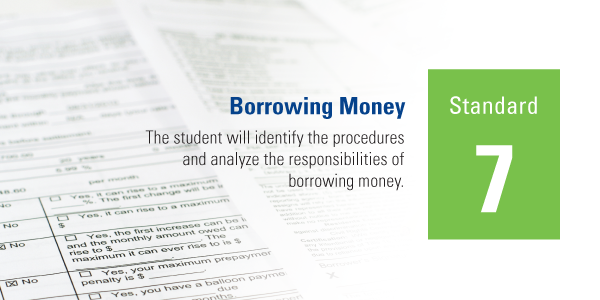PFL 7.1: Understanding Credit and Borrowing Options
PFL 7.2: The Impact of Credit History on Borrowing
PFL 7.3: The Borrowing Process
PFL 7.4: Responsibilities and Consequences of Borrowing
Complete Standard Detail Below Resources
Oklahoma State Department of Education: Making $en$e: Financial Success Curriculum and Frameworks | view now
Lessons, Activities, Calculators and Video Resources
PFL 7.1 Compare sources and products related to borrowing money.
A. Identify sources of credit (e.g., banks, credit unions, retail businesses, private lenders, and the federal government).
B. Describe various credit products (e.g., credit cards, car loans, and mortgages).
C. Compare sources of student loans (U.S. Department of Education versus private banks and credit unions) regarding eligibility, interest rates, and terms of repayment.
PFL 7.2 Analyze how one’s credit history impacts borrowing money and maintaining credit.
A. Explain the importance of establishing a positive credit history (e.g., favorable interest rates, employment, and financial opportunities).
B. Describe how credit reports compiled by credit bureaus are used to determine creditworthiness.
C. Identify the information contained in a credit report and how to access a free credit report.
D. Explain that a credit score is a numeric rating assessing an individual’s credit risk based on information from their credit report.
E. Identity factors that affect a credit score, such as payment history, credit utilization, amount owed, length of credit history, debt owed, and types of credit used.
PFL 7.3 Describe the process of borrowing money.
A. Identify factors involved in borrowing (e.g., credit history, credit report, debt to income ratio, loan to value ratio, and length of employment).
B. Explain how the terms of borrowing (e.g., interest rates, APR, fees, repayment schedules, terms, and conditions) affect the cost of borrowing.
C. Compare types of credit, including revolving and installment credit, and collateralized loans versus unsecured loans.
D. Differentiate between standard loan practices and predatory lending practices, such as rapid tax return and payday loans.
PFL 7.4 Analyze the responsibilities and consequences of borrowing money.
A. Identify consumer responsibilities, rights, and remedies, including fair debt collection practices protected by law.
B. Explain why responsible borrowers monitor their credit reports and how errors can be corrected.
C. Describe the impact of non-repayment of debt on individuals, families, businesses, and the broader economic system.
